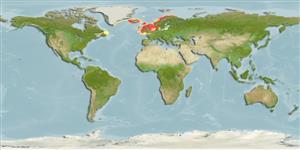>
Perciformes/Zoarcoidei (Eelpouts and pricklebacks) >
Stichaeidae (Pricklebacks) > Chirolophinae
Etymology: Chirolophis: Greek, cheir = hand + Greek, lophos = crest (Ref. 45335).
Eponymy: Peter Ascanius (1723–1803) was a Norwegian biologist who was one of Linnaeus’s students. [...] (Ref. 128868), visit book page.
More on author: Walbaum.
Environment: milieu / climate zone / depth range / distribution range
Ecología
marino bentopelágico; rango de profundidad 10 - 400 m (Ref. 58426), usually 10 - 30 m (Ref. 35388). Temperate; 72°N - 49°N, 70°W - 32°E
Northeast Atlantic: Norwegian coast to Finmarken and Waranger Fjord, occasionally Murman coast, rare in Skagerrak, Kattegat and Öresund, around Helgoland, also British Isles; also the Orkneys, Faroes, Shetlands and Iceland (Ref. 4782). Northwest Atlantic: Canada (Ref. 7251).
Tamaño / Peso / Age
Maturity: Lm ? range ? - ? cm
Max length : 25.0 cm SL macho / no sexado; (Ref. 4782); 18.0 cm TL (female); common length : 17.5 cm SL macho / no sexado; (Ref. 4782)
Espinas dorsales (total) : 50 - 54; Radios blandos dorsales (total) : 0; Radios blandos anales: 35 - 40. Snout blunt; mouth frog-like. With a large fringed tentacle above each eye, a smaller one in front and others on top of head and on the anterior dorsal fin spines. First anal fin ray a short flexible spine. Lateral line represented by a dorsal and a mediolateral branch of neuromasts (the former begins as a short canal, with 4-5 pores.
Usually over rocks and among seaweeds, never in intertidal zone, at 20 m, but descends from 100-280 m (Ref. 4782). Benthic (Ref. 58426). Feeds on bottom invertebrates (small mollusks, polychaetes, hydroids, sponges), also algae (Ref. 4782). Spawns in October - December (Ref. 35388).
Life cycle and mating behavior
Madurez | Reproducción | Puesta | Huevos | Fecundidad | Larva
Makushok, V.M., 1986. Stichaeidae. p. 1122-1123. In P.J.P. Whitehead, M.-L. Bauchot, J.-C. Hureau, J. Nielsen and E. Tortonese (eds.) Fishes of the North-eastern Atlantic and the Mediterranean. UNESCO, Paris. Vol. 3. (Ref. 4782)
IUCN Red List Status (Ref. 130435: Version 2024-2)
Threat to humans
Harmless
Human uses
Pesquerías: sin interés
Herramientas
Special reports
Download XML
Fuentes de Internet
Estimates based on models
Preferred temperature (Ref.
123201): 6.7 - 12, mean 10.1 °C (based on 278 cells).
Phylogenetic diversity index (Ref.
82804): PD
50 = 0.5039 [Uniqueness, from 0.5 = low to 2.0 = high].
Bayesian length-weight: a=0.00372 (0.00145 - 0.00954), b=3.17 (2.94 - 3.40), in cm total length, based on LWR estimates for this (Sub)family-body shape (Ref.
93245).
Nivel trófico (Ref.
69278): 3.2 ±0.36 se; based on food items.
Resiliencia (Ref.
120179): Bajo, población duplicada en un tiempo mínimo de 4.5-14 años (Preliminary K or Fecundity.).
Fishing Vulnerability (Ref.
59153): Low vulnerability (21 of 100).
Nutrients (Ref.
124155): Calcium = 35.6 [18.1, 64.6] mg/100g; Iron = 0.259 [0.148, 0.482] mg/100g; Protein = 17 [16, 18] %; Omega3 = 0.43 [0.21, 0.85] g/100g; Selenium = 17.5 [7.4, 39.2] μg/100g; VitaminA = 34.8 [8.0, 146.6] μg/100g; Zinc = 0.816 [0.551, 1.189] mg/100g (wet weight);
